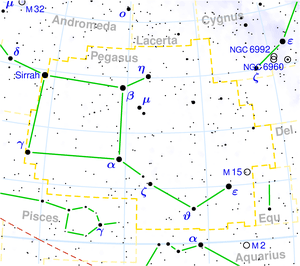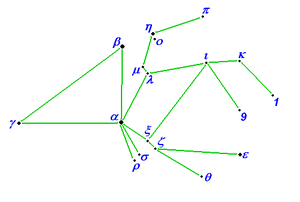.
Pegasus (constellation)
Pegasus is a northern constellation, named after the mythological winged horse Pegasus. It is one of the 88 modern constellations, and was also one of the 48 constellations listed by Ptolemy.
Features
 |
|
| List of stars in Pegasus | |
| Abbreviation: | Peg |
| Genitive: | Pegasi |
| Symbology: | the Winged Horse / Pegasus |
| Right ascension: | 23 h |
| Declination: | +20° |
| Area: | 1121 sq. deg. (7th) |
| Main stars: | 9, 17 |
| Bayer/Flamsteed stars: | 87 |
| Stars known to have planets: | 5 |
| Bright stars: | 5 |
| Nearby stars: | 2 |
| Brightest star: | ε Peg (Enif) (2.39m) |
| Nearest star: | ι Peg (38.3 ly) |
| Messier objects: | 1 |
| Meteor showers: | July Pegasids |
| Bordering constellations: | Andromeda Lacerta Cygnus Vulpecula Delphinus Equuleus Aquarius Pisces |
| Visible at latitudes between +90° and −60° Best visible at 21:00 (9 p.m.) during the month of October |
|
α Peg (Markab), β Peg, and γ Peg, together with α Andromedae (Alpheratz or Sirrah) form the large asterism known as the Square of Pegasus. 51 Pegasi, a star in this constellation, is the first Sun-like star known to have an extrasolar planet. IK Pegasi is the nearest supernova candidate. Spectroscopic analysis of HD 209458 b, an extrasolar planet in this constellation has provided the first evidence of atmospheric water vapour beyond the solar system.
Deep sky objects
* M15 - a globular cluster near the head (ε Peg) of Pegasus.
* NGC 7742 - a Type 2 Seyfert galaxy.
History and mythology
Pegasus was born from the blood of Medusa when she was slain by Perseus.
Pegasus has an appearance resembling a grazing horse, with a large square area as its body.[1] Due to the presence of the 4 brightest stars in the square, i.e. the 4 horses of Pegasus, this may be part of the origin of the myth of the Mares of Diomedes, one of The Twelve Labours of Heracles, together with another feature in the Zodiac sign of Aquarius, namely Aquarius itself, pouring out the waters.
The star formerly known as Delta Pegasi (labeled "Sirrah" in the map), one of the 4 stars in Pegasus' square, is now considered to be part of Andromeda, (α Andromedae) and is more usually called "Alpheratz." By moving the star, the square became a triangle attached to a stick body, thus resembling a wing. As a winged horse, Pegasus features in Greek mythology as its namesake, Pegasus.
Visualizations

Diagram of alternate way to connect the stars in the constellation Pegasus. Pegasus is shown to be a winged horse.
The body of the horse consists of a quadrilateral formed by the stars α Peg, β Peg, γ Peg, and α And.
The front legs of the winged horse are formed by two crooked lines of stars, one leading from η Peg to κ Peg and the other from μ Peg to 1 Pegasi.
Another crooked line of stars from α Peg via θ Peg to ε Peg forms the neck and head; ε is the snout.
Citations
1. ^ http://www.coldwater.k12.mi.us/lms/planetarium/myth/Peg.gif
References
* H. A. Rey, The Stars — A New Way To See Them. Enlarged World-Wide Edition. Houghton Mifflin, Boston, 1997. ISBN 0-395-24830-2.
* Ian Ridpath and Wil Tirion (2007). Stars and Planets Guide, Collins, London. ISBN 978-0007251209. Princeton University Press, Princeton. ISBN 978-0691135564.
Links
|
The 88 modern constellations
Andromeda | Antlia | Apus | Aquarius | Aquila | Ara | Aries | Auriga | Boötes | Caelum | Camelopardalis | Cancer | Canes Venatici | Canis Major | Canis Minor | Capricornus | Carina | Cassiopeia | Centaurus | Cepheus | Cetus | Chamaeleon | Circinus | Columba | Coma Berenices | Corona Australis | Corona Borealis | Corvus | Crater | Crux | Cygnus | Delphinus | Dorado | Draco | Equuleus | Eridanus | Fornax | Gemini | Grus | Hercules | Horologium | Hydra | Hydrus | Indus | Lacerta | Leo | Leo Minor | Lepus | Libra | Lupus | Lynx | Lyra | Mensa | Microscopium | Monoceros | Musca | Norma | Octans | Ophiuchus | Orion | Pavo | Pegasus | Perseus | Phoenix | Pictor | Pisces | Piscis Austrinus | Puppis | Pyxis | Reticulum | Sagitta | Sagittarius | Scorpius | Sculptor | Scutum | Serpens | Sextans | Taurus | Telescopium | Triangulum | Triangulum Australe | Tucana | Ursa Major | Ursa Minor | Vela | Virgo | Volans | Vulpecula |
Retrieved from "http://en.wikipedia.org/"
All text is available under the terms of the GNU Free Documentation License

